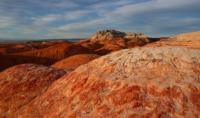You are here
Kein-Keriish valley.

Tours to Kazakhstan.
“The machine does not isolate man from the great problems of nature but plunges him more deeply into them”
Antoine de Saint-Exupery.
Tour to Kein-Keriish valley.
The area around Zaysan Lake was once famous for the herds of wild Bactrian camels and Przewalski's horses that grazed on its shores. Until around 100 years ago, tiger, kulan, saiga and dzheyran could also be found here, with herds counted in the thousands; biologists came from all around the world to observe this Earthly paradise.
Zaysan Lake is a very large water basin on the southern outskirts of the Altai, and a rich fishing ground. It is approximately 100 kilometres long, up to 31 kilometres wide but only eight metres deep, fed by the Black Irtysh, which comes from China and widens here to create an area of more than 1,800 square kilometres.
Since ancient times, people have moved through the natural gateway through the mountains created by the river: caravans, conquerors, nomads and entire nations searching for new places to settle.
The northernmost branch of the Silk Road once ran along the foot of the mountain chains of Saur and Manyrak, beyond Zaysan.
Here, on the south bank of the lake, is the only driveable road that leads from the Chinese border near Maykapshagay (Fat Gorge) via Semey to Pavlodar. The lake's shores consist of exotic desert landscapes. To the south lie the wild mountain spurs of Manyrak and the mighty snow-covered Saur, with its 3,816-metre peak Muztau (Ice Mountain).
Behind it stretches the Tarbagatay mountain range, much of which has probably never been properly explored by humans. Here argali sheep and snow leopards still find refuge. On the north shore, there are places where you could imagine yourself to be on the planet Mars.
Red and yellow clay hills dominate the areas bordering the Bay of Shakelmes and in the territory of Kein-Keriish (Flaming Rocks). Melting water has eroded the rock into bizarre-looking and wonderfully carved formations.
With a bit of imagination it's possible to imagine an entire city spread over 300 hectares: towers, castles and yurts, all glowing in various hues. Extreme heat and a lack of water characterize this rough, fantasy landscape.
Kiein-Keriish is only accessible by jeep, either by turning right on the road from Kurshum to Buran where the branch road to Karatogay begins, and driving across the lifeless deseit in the direction of Amana, or trying to make it along the lake's shore.
Whichever way you choose, a knowledgeable guide is essential. Camping on Zaysan Lake is an experience. From time to time at night, in the absence of human-made noise, one hears a wind-borne sound over the lake and between the mountains that is reminiscent of the humming of telegraph lines.
It is to this Aeolian tune that the lake owes its m ongolian nickname of Khut-khutu Nor (Lake of the Ringing Chimes). However, if want to camp Ае lakeside, make sure you pitch your tent at least 20 metres from thi horeline, becauseш.night there can often be big waves.
Authority:
The guidebook across Kazakhstan. Authors Dagmar Schreiber and Jeremy Tredinnick. Publishing house "Odyssey".2010.
Photos
Alexander Petrov.







